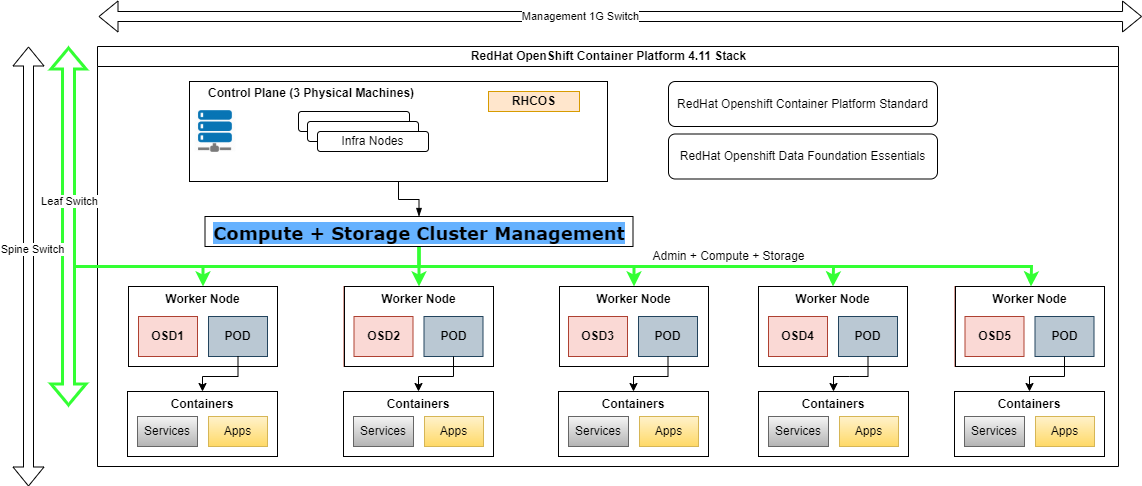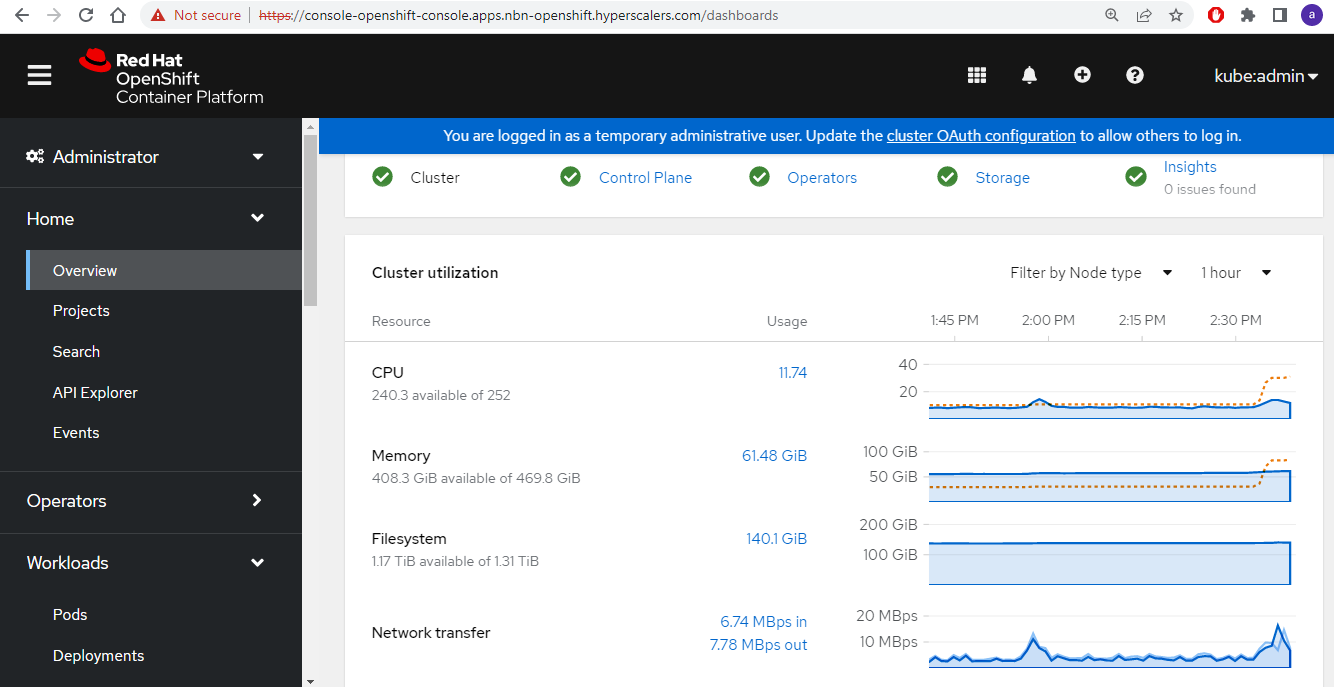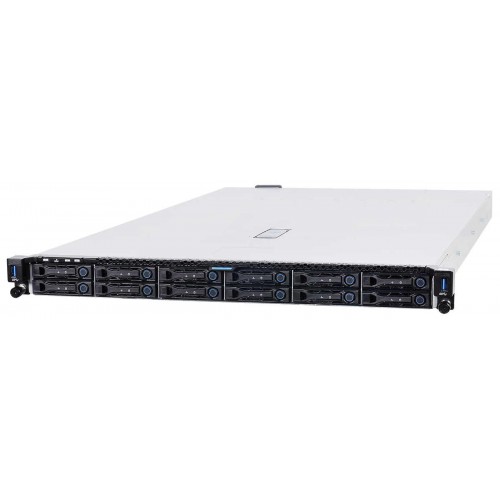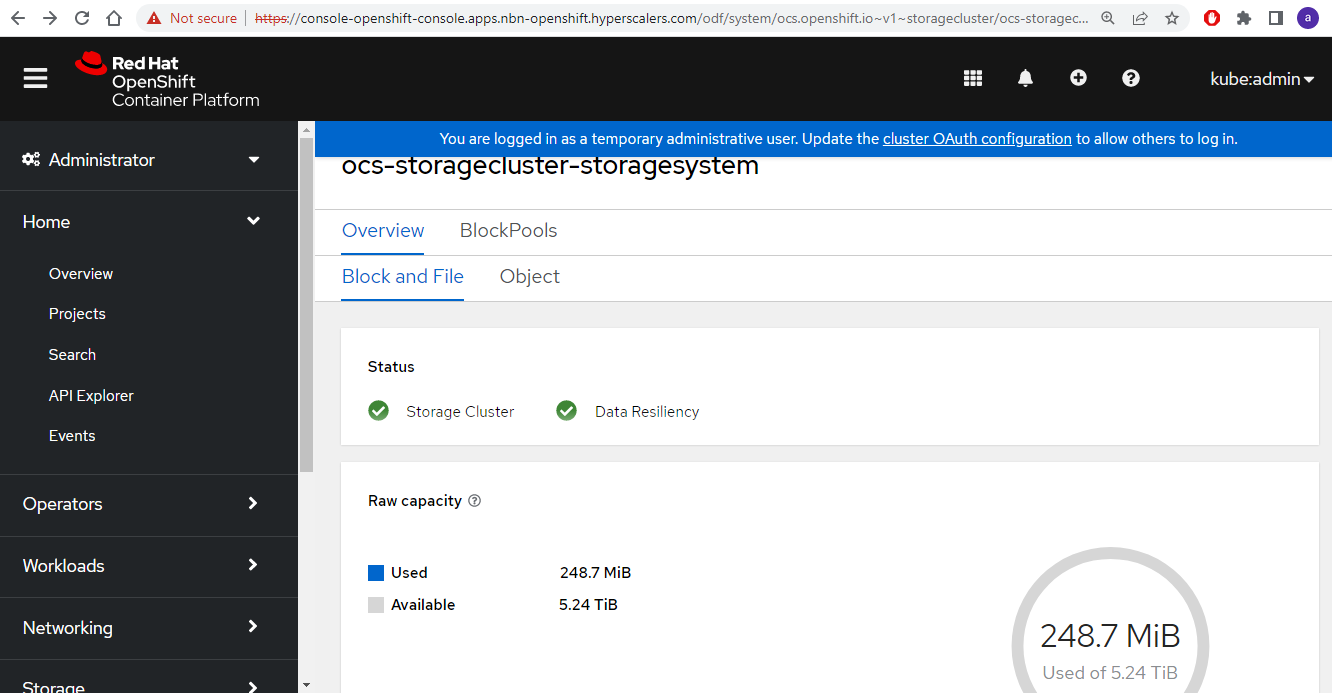Hyperconverged Red Hat OpenShift Container Platform with Data Foundation
Features:
- Persistent Storage
- Virtual Machines orchestration IaaS
- Container orchestration (cloud native apps) PaaS
- Multi cluster management
- Advanced security and compliance
-
$USD $420,000.00
*RRP Pricing*To View Channel Discounts Please Login
Hyperconverged Red Hat OpenShift Container Platform with Data Foundation
HYPERSCALERS with Red Hat 
Red Hat® OpenShift® is an enterprise-ready Kubernetes container platform based on a unified architectural vision and supported by an open hybrid cloud strategy.
Using OpenShift, applications and the data centres that support them can expand safely and securely from just a few machine and application instances to thousands of instances that serve millions of clients.
Hyperscalers understands the need for Enterprise service providers and IT administrators to run and manage virtual machine (VM) and container workloads side by side on a single platform.
OpenShift can fulfill this requirement by allowing you to develop, manage, and deploy virtual machines side-by-side with containers and serverless across a common hyperconverged storage pool.
Hyperscalers has partnered with Red Hat to engineer and qualify a purpose-built, Hyperconverged Red Hat OpenShift Container Platform that incorporates all these features under a single hardware and software architecture that is jointly engineered and supported by Hyperscalers and Red Hat.
As a key part of this, the OpenShift Data Foundation supports a collection of on-demand storage and data service types that is tightly integrated within the OpenShift Platform.
The Hyperconverged OpenShift Platform enables you to leverage powerful storage technology breakthroughs that can deliver significant performance and/or capacity improvements such as you might require for your specific implementation.
These storage products have been tested within Hyperscalers rigorous laboratory environment for compatibility at all levels of the solution architecture, saving you from unexpected hardware, baseboard management, device driver and software stack issues.
Support for all components delivered within the Hyperconverged OpenShift Platform solution architecture is provided by Hyperscalers as part of initial solution delivery and during your ongoing support relationship with us.
Regardless of whether your primary focus is to leverage OpenShift continuous integration and continuous delivery (CI/CD) pipeline capabilities, and/or to support consistent management of hybrid cloud, multi-cloud, and edge deployments, the Hyperconverged Red Hat OpenShift Container Platform can provide you with the capacity, performance and availability capabilities and attributes that your organisation requires.
Infrastructure
Production level hardware requirements

Building Blocks:
Start configuring using Hyperscalers Servers
|
|
|
Download the full reference guide in the downloads tab.
Features of Hyperconverged Red Hat OpenShift Container Platform with Data Foundation

Benefits of Red Hat OpenShift:
Scalability
Flexibility:
Open-source standards
Container portability

Automated installation and upgrades
Automated installation and over-the-air platform upgrades are supported in cloud with Amazon Web Services, Google Cloud Platform, IBM Cloud, and Microsoft Azure, and on-premises using vSphere, Red Hat OpenStack Platform, Red Hat Virtualization, or bare metal. Services used from the Operator Hub can be deployed fully configured and are upgradable with 1 click.
Automation
Streamlined and automated container and app builds, deployments, scaling, health management, and more are included.
Edge architecture support
Red Hat OpenShift enhances support of smaller-footprint topologies in edge scenarios that include 3-node clusters, single-node Red Hat OpenShift, and remote worker nodes, which better map to varying physical size, connectivity, and availability requirements of different edge sites. The edge use cases are further enhanced with support for Red Hat OpenShift clusters on ARM architecture, commonly used for low-power-consumption devices.
Multi-cluster management
Red Hat OpenShift with Red Hat Advanced Cluster Management for Kubernetes can easily deploy apps, manage multiple clusters, and enforce policies across clusters at scale.
Advanced security and compliance
Red Hat OpenShift offers core security capabilities like access controls, networking, and enterprise registry with built-in scanner. Red Hat Advanced Cluster Security for Kubernetes enhances this with security capabilities like runtime threat detection, full life cycle vulnerability management, and risk profiling.
Persistent storage
Red Hat OpenShift supports a broad spectrum of enterprise storage solutions, including Red Hat OpenShift Data Foundation, for running both stateful and stateless apps.
Robust ecosystem
An expanding ecosystem of partners provides a wide variety of integrations. Third parties deliver additional storage and network providers, IDE, CI, integrations, independent software vendor solutions, and more.
Power of Kubernetes
Within OpenShift Container Platform, Kubernetes manages containerized applications across a set of containers or hosts and provides mechanisms for deployment, maintenance, and application-scaling. The container runtime packages, instantiates, and runs containerized applications.
Install Operators
Red Hat OpenShift platform provides several operators that are pre-engineered to perform specific applications like Elastic Search, Kafka, SSL certificate management etc. Please note that a subscription to individual services may be required to use the applications in Red Hat OpenShift environment.
Kafka, MinIO object storage and Prometheus monitoring deployed in Red Hat OpenShift
OpenShift Data Foundation
Ceph based persistent storage previously called Red Hat OpenShift Container Storage—is software-defined storage for containers. It provides cluster data management capabilities that lets organizations deploy their apps and data management as needs dictate, and then adjust as they move forward.
Persistent volumes, Claims and Storage classes:
In a containerized environment, the storage is classified as Storage class which is consumed by the persistent volumes using the persistent volume claims. Each of the persistent volume claim is associated with an application which decides the size of the storage allocation to them. As mentioned earlier, Ceph is the underlying storage technology for the Red Hat OpenShift that can provide a block, filesystem, and object storage classes for the application to use from. Below are some of the screenshots that show the storage platform provided by the Red Hat Data Foundation.
Pods:
Pods are the basic unit of the containerized resource where an application resides. Pods can be replicated for high availability and the route to the application is defined in the pods. Every pod is associated with a namespace or project, and they can be accessed via SSH.
Virtualization:
Red Hat Virtualisation is enabled on the OpenShift using the Virtualization Operator. This enables the user to have the containers alongside the virtual machines to provide adaptability for application that are built for Kubernetes containers and those apps built for virtual machines. Hence, the same physical resource can used to deploy containerised as well as virtual machine-based workloads.
Cluster Upgrades and Subscription:
Red Hat OpenShift provides a 60-day free evaluation to setup and support your cluster deployment and then we can attach a license/subscription based on purchase period for the support and services. Cluster upgrade can run on the live environment without affecting the workload but it is highly recommended to understand the requirements of your workloads before upgrading as it could cause inter-operability issues within the apps in the container.
Start configuring using Hyperscalers Servers
|
|
|
Download the full reference guide in the downloads tab.
Infrastructure Setup
To demonstrate a scalable and resilient Red Hat OpenShift cluster, we have used 3 master nodes and 6 worker nodes with 4x local storage drives per worker nodes. The hardware configuration for the build is listed below:
Master nodes:
- 2x Intel® Xeon® Silver 4310T Processor 10c 3.40 GHz 2.30 GHz 15 MB
- 8x DDR4 25600 (3200Mhz) 32GB Register Samsung M393A4K40DB3-CWE
- 1x NIC OCP(Pull Tab) 25Gb SFP28 2 port MELLANOX CX631432A ConnectX-6 Lx PCI-E X 8 Gen 4 MCX631432AN-ADAB
- 2x OS SSD - M.2 PCIe SSD 250GB Samsung MZ-V7S250 (For OS 250 GB DWPD < 1)
Worker nodes:
- 2x CPU - Intel® Xeon® Gold 5320 Processor 26c 3.40 GHz 2.20 GHz 39 MB 185W
- 8x DDR4 25600 (3200Mhz) 32GB Register Samsung M393A4K40DB3-CWE
- 1x NIC OCP(Pull Tab) 25Gb SFP28 2 port MELLANOX CX631432A ConnectX-6 Lx PCI-E X 8 Gen 4 MCX631432AN-ADAB
- 2x OS SSD - M.2 PCIe SSD 250GB Samsung MZ-V7S250 (For OS 250 GB DWPD < 1)
- 4x NVMe 2.5'' U.2 NVMe 15mm PCI-e Gen4 X4 15.4TB Samsung PM1733 MZWLR15THALA-00007(O)

Software Stack:
- Operating System: Red Hat Enterprise Linux CoreOS (RHCOS) v4.11
- Cluster Deployment tool: Red Hat Hybrid Cloud Console
- Hyperconverged Storage Operator: OpenShift Data Foundation v4.11.2
- Virtualisation: OpenShift Virtualization v4.11.0
Contents Page - Download the Reference Guide in the Downloads Tab
Introduction 4
Audience and Purpose 6
Documents, Knowledge Base, and Technical Support 6
Features of Hyperconverged Red Hat OpenShift Container Platform with Data Foundation 7
Benefits of Red Hat OpenShift 8
Important Considerations 15
Digital IP Appliance Design Process 16
Appliance Optimizer Utility AOU 16
Infrastructure Setup 17
Building Blocks: 18
S5Z | T43Z-2U The Power of Hyper Convergence 19
S9CA | S43CA-2U AMD Density Optimized “EPYC” Multi-node Server 20
Access and Default Credentials 20
Terminologies 21
3 Base Product Deployment 22
Preinstallation Requirements 22
Installation Components 23
Deployment 24
4 Configure the Appliance 33
5 Testing the Appliance 38
6 Addendum 43
7 Copyright and Licensing 52
8 References 53
| Title | Version | Date | Size | |
|---|---|---|---|---|
| Hyperconverged Red Hat OpenShift Container Platform with Data Foundation |  |
| Title | Version | Date | Size | |
|---|---|---|---|---|
| Hyperconverged Red Hat OpenShift Container Platform with Data Foundation |  |
Tags: Hyperscalers, Hyperconverged Red Hat OpenShift Container Platform with Data Foundation


 AUS site
AUS site















